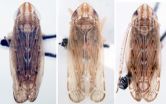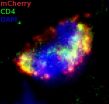(Press-News.org) A team of scientists using NASA's Hubble Space Telescope has made the most detailed global map yet of the glow from a turbulent planet outside our solar system, revealing its secrets of air temperatures and water vapor.
Hubble observations show the exoplanet, called WASP-43b, is no place to call home. It is a world of extremes, where seething winds howl at the speed of sound from a 3,000-degree-Fahrenheit "day" side, hot enough to melt steel, to a pitch-black "night" side with plunging temperatures below 1,000 degrees Fahrenheit.
Astronomers have mapped the temperatures at different layers of the planet's atmosphere and traced the amount and distribution of water vapor. The findings have ramifications for the understanding of atmospheric dynamics and how giant planets like Jupiter are formed.
"These measurements have opened the door for a new kinds of ways to compare the properties of different types of planets," said team leader Jacob Bean of the University of Chicago.
First discovered in 2011, WASP-43b is located 260 light-years away. The planet is too distant to be photographed, but because its orbit is observed edge-on to Earth, astronomers detected it by observing regular dips in the light of its parent star as the planet passes in front of it.
"Our observations are the first of their kind in terms of providing a two-dimensional map on the longitude and altitude of the planet's thermal structure that can be used to constrain atmospheric circulation and dynamical models for hot exoplanets," said team member Kevin Stevenson of the University of Chicago.
As a hot ball of predominantly hydrogen gas, there are no surface features on the planet, such as oceans or continents that can be used to track its rotation. Only the severe temperature difference between the day and night sides can be used by a remote observer to mark the passage of a day on this world.
The planet is about the same size as Jupiter, but is nearly twice as dense. The planet is so close to its orange dwarf host star that it completes an orbit in just 19 hours. The planet also is gravitationally locked so that it keeps one hemisphere facing the star, just as our moon keeps one face toward Earth.
This was the first time astronomers were able to observe three complete rotations of any planet, which occurred during a span of four days. Scientists combined two previous methods of analyzing exoplanets in an unprecedented technique to study the atmosphere of WASP-43b. They used spectroscopy, dividing the planet's light into its component colors, to determine the amount of water and the temperatures of the atmosphere. By observing the planet's rotation, the astronomers also were able to precisely measure how the water is distributed at different longitudes.
Because there is no planet with these tortured conditions in our solar system, characterizing the atmosphere of such a bizarre world provides a unique laboratory for better understanding planet formation and planetary physics.
"The planet is so hot that all the water in its atmosphere is vaporized, rather than condensed into icy clouds like on Jupiter," said team member Laura Kreidberg of the University of Chicago.
The amount of water in the giant planets of our solar system is poorly known because water that has precipitated out of the upper atmospheres of cool gas giant planets like Jupiter is locked away as ice. But so-called "hot Jupiters," gas giants that have high surface temperatures because they orbit very close to their stars, water is in a vapor that can be readily traced.
"Water is thought to play an important role in the formation of giant planets, since comet-like bodies bombard young planets, delivering most of the water and other molecules that we can observe," said Jonathan Fortney, a member of the team from the University of California, Santa Cruz.
In order to understand how giant planets form astronomers want to know how enriched they are in different elements. The team found that WASP-43b has about the same amount of water as we would expect for an object with the same chemical composition as our sun, shedding light on the fundamentals about how the planet formed. The team next aims to make water-abundance measurements for different planets.
The results are presented in two new papers, one published online in Science Express Thursday and the other published in the Astrophysical Journal Letters on Sept. 12.
INFORMATION:
The Hubble Space Telescope is a project of international cooperation between NASA and the European Space Agency. NASA's Goddard Space Flight Center in Greenbelt, Maryland manages the telescope. The Space Telescope Science Institute (STScI) in Baltimore conducts Hubble science operations. STScI is operated for NASA by the Association of Universities for Research in Astronomy, Inc., in Washington.
For images and more information about Hubble, visit:
http://www.nasa.gov/hubble
and
http://hubblesite.org/news/2014/28
Researchers at the Wyss Institute for Biologically Inspired Engineering at Harvard University have unveiled a new method to form tiny 3D metal nanoparticles in prescribed shapes and dimensions using DNA, Nature's building block, as a construction mold.
The ability to mold inorganic nanoparticles out of materials such as gold and silver in precisely designed 3D shapes is a significant breakthrough that has the potential to advance laser technology, microscopy, solar cells, electronics, environmental testing, disease detection and more.
"We built tiny foundries made ...
MADISON, Wis. – In Wisconsin, bioenergy is for the birds. Really.
In a study published today in the journal PLOS ONE, University of Wisconsin-Madison and Wisconsin Department of Natural Resources (DNR) scientists examined whether corn and perennial grassland fields in southern Wisconsin could provide both biomass for bioenergy production and bountiful bird habitat.
The research team found that where there are grasslands, there are birds. Grass-and-wildflower-dominated fields supported more than three times as many bird species as cornfields, including 10 imperiled ...
Three new species of leafhoppers from China in the genus Futasujinus were recently identified during a review of leafhoppers in museum collections in China, the UK, and Illinois. One of them, Futasujinus dietrichi, was "named after Dr. Chris Dietrich, University of Illinois, USA, in recognition of his good work on leafhoppers." The new species are described in an article in Annals of the Entomological Society of America.
The other two species are Futasujinus truncatus and Futasujinus hastatus. Both species epithets allude to processes on their aedeagal shafts.
All three ...
Tempe, Ariz. (Oct. 9, 2014) - New Ebola research demonstrates that quick and forceful implementation of control interventions are necessary to control outbreaks and avoid far worse scenarios.
Researchers analyzed up-to-date epidemiological data of Ebola cases in Nigeria as of Oct. 1, 2014, in order to estimate the case fatality rate, proportion of health care workers infected, transmission progression and impact of control interventions on the size of the epidemic.
"Rapid and forceful control measures are necessary as is demonstrated by the Nigerian success story. This ...
A Greek and international team of divers and archaeologists has retrieved stunning new finds from an ancient Greek ship that sank more than 2,000 years ago off the remote island of Antikythera. The rescued antiquities include tableware, ship components, and a giant bronze spear that would have belonged to a life-sized warrior statue.
The Antikythera wreck was first discovered in 1900 by sponge divers who were blown off course by a storm. They subsequently recovered a spectacular haul of ancient treasure including bronze and marble statues, jewellery, furniture, luxury ...
WEST LAFAYETTE, Ind. – A new technique makes it possible to quickly detect the presence of drugs or to monitor certain medical conditions using only a single drop of blood or urine, representing a potential tool for clinicians and law enforcement.
The technique works by extracting minute quantities of target molecules contained in specimens of blood, urine or other biological fluids, and then testing the sample with a mass spectrometer.
Testing carried out with the technology takes minutes, whereas conventional laboratory methods take hours or days to yield results ...
SAN FRANCISCO -- The information that interprets the genetic code in a new embryo differs depending on whether it comes from the father or mother, researchers at San Francisco State University have found.
The research, detailed in an article published today in the journal PLOS Genetics, sheds light on the multilayered process of how a sperm and egg pass along information needed for successful reproduction. Though one layer is the DNA code that is transferred, the new study identifies information not encoded by DNA, a so-called "epigenetic" layer of information that helps ...
Most women are infected with HIV through vaginal intercourse, and without effective vaccines or microbicides, women who cannot negotiate condom use by their partners remain vulnerable. How exactly the virus establishes infection in the female reproductive tract (FRT) remains poorly understood. A study published on October 9th in PLOS Pathogens reports surprising results from a study of HIV transmission in the FRT of rhesus macaques.
Most studies of HIV transmission after vaginal exposure to date have been done in rhesus macaques and focused on the cervix, the lower part ...
VIDEO:
This video explains research done to understand the motion used by sidewinder snakes to climb sandy slopes and to apply that motion to a snake-like robot. Researchers from Georgia Tech,...
Click here for more information.
The amazing ability of sidewinder snakes to quickly climb sandy slopes was once something biologists only vaguely understood and roboticists only dreamed of replicating. By studying the snakes in a unique bed of inclined sand and using a snake-like robot ...
CANCER RESEARCH UK scientists have discovered that lung cancers can lie dormant for over 20 years before suddenly turning into an aggressive form of the disease, according to a study published in Science* today (Thursday).
The team studied lung cancers from seven patients – including smokers, ex-smokers and never smokers. They found that after the first genetic mistakes that cause the cancer, it can exist undetected for many years until new, additional, faults trigger rapid growth of the disease.
During this expansion there is a surge of different genetic faults ...





